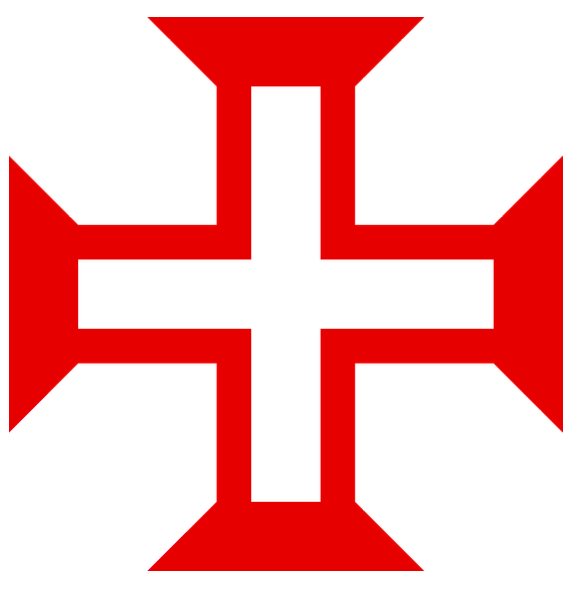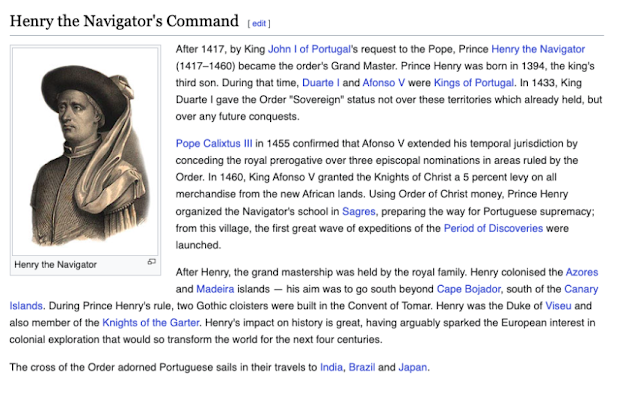Introduction:
The Knights Templar, a name that evokes images of medieval knights in shining armor, embarked on a journey that began in the early 12th century with the primary mission of safeguarding Christian pilgrims traveling to the Holy Land. Founded around 1119, the Templars rapidly grew into one of the most formidable military and financial organizations in Europe, known for their distinctive white mantles emblazoned with a red cross. However, their meteoric rise was met with a dramatic fall when, in 1307, King Philip IV of France, driven by greed and political machinations, orchestrated their arrest, leading to their official disbandment by Pope Clement V in 1312.
Yet, the story of the Templars did not end there. In Portugal, the legacy of the Templars was preserved through the establishment of the Military Order of Christ by King Denis in 1319. This new order absorbed many of the former Templar knights and their assets, continuing their traditions and influence. The Military Order of Christ played a pivotal role in the Portuguese Age of Exploration, with figures like Prince Henry the Navigator using its resources and prestige to push the boundaries of the known world.
Today, the Order of Christ exists as an honorary order in Portugal, celebrating notable contributions to society and the state. This transformation from medieval crusaders to modern honorary order highlights the enduring legacy and adaptability of the Knights Templar across centuries.
Military Order of Christ
From Wikipedia: https://en.wikipedia.org/wiki/Military_Order_of_Christ
The Military Order of Christ[a] is the former order of Knights Templar as it was reconstituted in Portugal. Before 1910, it was known as the Royal Military Order of Our Lord Jesus Christ,[b] and the Order of the Knights of Our Lord Jesus Christ.[c]
It was founded in 1319,[1][2] with the protection of King Denis of Portugal, after theTemplars were abolished on 22 March 1312 by the papal bull, Vox in excelso, issued by Pope Clement V.[3][4] King Denis refused to pursue and persecute the former knights as had occurred in most of the other sovereign states under the political influence of the Catholic Church.
Heavily swayed by Philip IV of France, Pope Clement had the Knights Templar annihilated throughout France and most of Europe on charges of heresy, but Denis revived the Templars of Tomar as the Order of Christ, largely for their aid during the Reconquista and in the reconstruction of Portugal after the wars. Denis negotiated with Clement's successor, John XXII, for recognition of the new order and its right to inherit the Templar assets and property. This was granted in a papal bull, Ad ea ex quibus, on 14 March 1319.[5] There exists also a parallel Supreme Order of Christ of the Holy See, the Order of Christ of the House of Orléans-Braganza, and the Order of Christ of Kongo.[6]
The order's origins lie in the Knights Templar, founded circa 1118. The Templars were persecuted by the king of France and eventually disbanded by the pope in 1312. King Dinis I of Portugal created the Order of Christ in 1319 for those knights who survived their mass slaughter throughout Europe.[7] In Portugal, the Order of Christ accumulated great riches and power during the Age of Discoveries.
In 1789, Queen Maria I of Portugal secularized the order.[7] In 1910, with the end of the
Portuguese monarchy, the order was extinguished. However, in 1917, the order was revived, with its Grand Master to be the President of Portugal. The Military Order of Christ, together with the Military Orders of Aviz and of St. James of the Sword, formed the group of the "Ancient Military Orders", governed by a chancellor and a council of eight members, and appointed by the President of the Republic to assist him as Grand Master in all the order's administrative matters. The Order can be conferred for outstanding services to the Republic on military officers, and, despite its name, on civilians (including foreigners as well as Portuguese citizens) and on members of: Parliament or other branches of government, the diplomatic corps, the Courts of Justice, he Civil Service, and other public authorities.[8]
People associated with the Order of Christ
Star and riband of a Knight Grand Cross of the Order of Christ
Grand Masters[edit]
-
● Henry the Navigator (Grand Master)
-
● Manuel I (Grand Master)
-
● Infante Ferdinand (Grand Master)
-
● Sebastian of Portugal (Grand Master)
Others[edit]
-
● John Alexander Fladgate (Commander)
-
● Vasco da Gama (also to the Order of Santiago before)
-
● Pedro Álvares Cabral
-
● João Gonçalves Zarco
-
● Gonçalo Velho Cabral
-
● Bartolomeu Dias
5
-
● D. Beatrice
-
● Francisco de Almeida
-
● Miguel Corte-Real
-
● Gaspar Corte-Real
-
● Tristão da Cunha
-
● Martim Afonso de Sousa
-
● João de Castro
-
● Cristóvão da Gama
-
● Tomé de Sousa
-
● FernãodeMagalhães, alsoknownasFerdinandMagellan
(also to the Order of Santiago)
-
● Vicente Sodré
-
● Damião de Góis
-
● Pedro Teixeira
-
● Alexandre de Gusmão
-
● Alexandre Rodrigues Ferreira
-
● Henrique Dias
-
● António Filipe Camarão
-
● Jácome Ratton
-
● Albert Coyette
-
● Louis-Nicolas Davout
-
● Jean-Baptiste Bessières
-
● Albert Guille
-
● Guillaume Delcourt
-
● Ângelo Moniz da Silva Ferraz, Baron of Uruguaiana
-
● Prince Philip, Duke of Edinburgh (Grand Cross)
-
● Jules Ernest Renoux
6
History of the Order of Christ
https://en.wikipedia.org/wiki/History_of_the_Order_of_Christ
The Military Order of Christ (previously Ordem dos Cavaleiros de Cristo "Order of the Knights of Christ") was founded in 1318. The order, in every sense of the term, were Knights Templar who continued their operations from their headquarters in Tomar, Santarém Portugal. Contrary to the belief that the Templar Order was renamed and established by King Denis of Portugal, the Templars merely moved backed to their original headquarters in Tomar Castle which was an autonomous zone granted to the Templar Order. Reasons for this move and change of name were to protect the vast assets of the order from repatriation by the Catholic Church. The Templar assets were then transferred over to the Cavaleiros de Cristo, all with the blessing of King Diniz who helped pull off the deal with the Church.
The order was secularized in 1789, and dissolved in 1910. It was revived in 1917 within the Portuguese Republic, headed by the President of Portugal, as a decoration in recognition of outstanding services to the state.
he Templars were founded around 1118 and soon formed commanderies around Europe to support their efforts in the Holy Land, settling in Portugal at least since 1122, in the region of Braga, where the Order received successive donations and where they also bought lands. This occurred only two or three years after their foundation in Jerusalem, and about 7 years before their recognition and confirmation in the Council of Troyes.[1] The Templars also received lands donated by D. Theresa in 1126, a few years before Portugal became a fully independent kingdom.[2] Portugal was the first country in Europe where they settled.[3]
Gualdim Pais, provincial Master of the Order of the Temple in Portugal, constructed the Convento de Cristo in 1160. According to folklore, he chose the location after drawing lots and receiving a sign to build a new Templar fortress on a hill between the river Fria and Saint Gregory's creek. Traditional local legends and chronicles preach that the choice was for mystical reasons and by divine inspiration, from practices like geomancy by the provincial Grand Master, based on exercises taken from luck and predestination. Reinforcing this magical view is the fact that the lot was part of a small chain of seven elevations (lugar dos sete montes), which became known as the city of seven hills, as the seven hills of Jerusalem, the seven hills of Rome or the seven columns of Constantinople.[4]
The "Convento de Cristo" in Tomar, central Portugal.
The Convento de Cristo is a testament to the Templars' architectural abilities.[5] The octagonal church was inspired by the Islamic Dome of the Rock shrine in Jerusalem,
used by the Templars as their base of operations. The Dome of the Rock is located on
the Temple Mount, where the Temple of Jerusalem stood prior to its destruction in 70
A.D., and the Templars believed the Dome of the Rock was a remnant of the ancient Temple from which their name derives. The order incorporated features of the shrine
into their imagery and architecture, including the seals of Grand-Masters. The
architecture of the Church of the Holy Sepulchre may have also served as a model. The
sepulchre itself stands in an elaborate structure within the rotunda (rotunda – 35 m
diameter), surrounded by a group of three columns between four pairs of square piers
columns supporting an ornamented, domed roof. It is possible that the 4th-century
rotunda's columns were removed from their original location on the façade of the
Roman temple. Renovation of the piers exposed evidence that the columns had
originally been much higher and that the Crusaders cut them in half for use in the
12th-century rotunda.
On 13 July 1190, Abu Yusuf Yaqub al-Mansur, the King of Morocco laid siege to the Templars in Tomar. This test of strength confirmed the Templars' military power and established them as an indispensable presence in the defense of northern Portugal. Pais died in 1195 after ruling for 50 years.
Birth of the Order
After the Templar order's suppression by Pope Clement in 1312, King Denis set about creating a new order for the displaced knights in his realm. He instituted the "Christi Militia" under the patronage of Saint Benedict in 1317 (some sources say August 14, 1318), and Pope John XXII approved this order by a Papal bull on 14 March 1319, "
After four years of negotiations, Pope John XXII passed another bull authorizing Denis to grant the Templar's property to the Order of the Christ in 1323. The knights of the order were committed to vows of poverty, chastity and obedience to the king. It is unclear how many Templars continued in the new order; some historians would claim the Order of Christ was essentially the Templars under a new name, while others see it as a mostly original formation. The first Grand Master, Dom Gil Martins, had been a knight of Saint Benedict in the Order of Aviz.
The Order of Christ was first seated at Castro Marim, in the Algarve (in the Diocese of Faro). In 1357, the order was moved to the town of Tomar, near Santarém, former seat of the Order of the Knights Templars in Portugal. (Other sources give the movement date 1366 under the sixth Grand Master, Dom Nuno Rodrigues.)
Also:
https://taughtbydegree.wordpress.com/2019/06/08/knights-templars-legacy-i n-the-philippines/








No comments:
Post a Comment